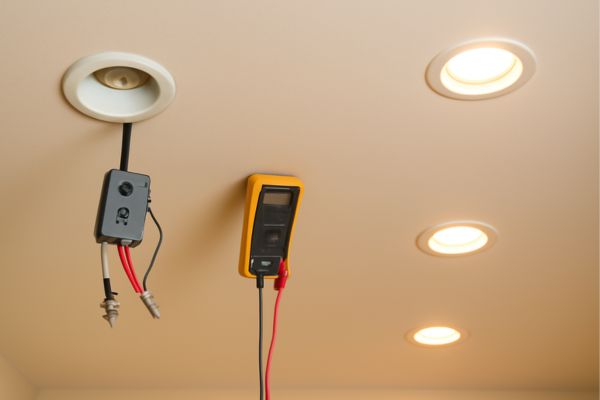Have you ever walked into a room and seen your recessed lights flickering? It’s a common issue that can be annoying. At first, you might ignore it, but soon, you start asking yourself why it’s happening. Flickering lights often point to bigger problems in your electrical system. It could be a loose bulb, faulty wiring, or even an overload. Addressing these issues early can prevent further damage. In this article, we’ll cover why recessed lights flicker and how you can fix them. I’ll also share tips to help prevent this problem from happening again. Let’s dive in and get your lights working perfectly.
What Causes Recessed Lights to Flicker?

Faulty Bulbs:
A bulb that’s about to burn out can cause flickering. They Are often in hard-to-reach spots, So you may not notice the bulb’s age. Replacing the bulb usually fixes the problem.
Loose Connections:
Loose or damaged wiring can also cause flickering. If the connections aren’t secure, Power flow becomes inconsistent. Tightening loose connections often solves the issue.
Dimmer Switches:
Dimmer switches sometimes cause flickering. Not all bulbs work well with dimmers, Especially LEDs. Be sure to check your bulbs’ Compatibility with the dimmer.
Voltage Fluctuations:
Large appliances, like fridges or air conditioners, Can cause voltage dips. These dips disrupt the power and cause flickering.
Circuit Overload:
Too many devices on the same circuit can overload it. This can lead to unstable power, Causing lights to flicker. Moving devices to different circuits can help.
How to Troubleshoot Flickering Recessed Lights

Step 1: Check the Bulb
Start by inspecting the bulb. Look for any loose or faulty bulbs. If needed, swap them out for new ones.
Step 2: Tighten Loose Connections
Next, check the light fixture for loose wiring. A simple tightening of any loose connections can often stop the flickering.
Step 3: Test the Dimmer
If you have a dimmer switch, check its compatibility with your bulbs. Not all bulbs work well with certain dimmers, so ensure they match.
Step 4: Check the Voltage
Use a multimeter to measure the voltage in your system. Too much fluctuation could indicate a larger power issue.
Step 5: Evaluate Circuit Load
Too many devices on one circuit can cause flickering. Consider redistributing some devices to different circuits to reduce the load.
Practical Tips for Fixing Flickering

Tip 1: Replace Bulbs with Compatible Types
Use bulbs specifically designed for recessed lighting, Especially the best recessed lighting for bathrooms. Not all bulbs are suitable for these fixtures, so make sure to pick the right ones. This can prevent flickering and ensure your lights work properly.”
Tip 2: Hire a Professional
If the flickering continues, it may be time to call an electrician. An expert can safely resolve any wiring issues that could be causing the problem.
Tip 3: Consider LED Bulbs
Switching to LED bulbs can help reduce flickering. LEDs are more energy-efficient and less likely to flicker due to voltage fluctuations.
Different Types of Recessed Lights and When to Use Each
IC-rated
IC-rated lights are safe for use in ceilings with insulation. These lights are designed to handle heat without causing fire hazards. They are ideal for attics or areas with insulation.
Non-IC-rated
Non-IC-rated lights are not safe for use in insulated ceilings. They can overheat, leading to potential fire risks. These are best for areas without insulation, such as open spaces or unfinished ceilings.
LED vs. Halogen Bulbs
LED bulbs are energy-efficient and last longer than halogen bulbs. They are less prone to flickering, especially with voltage fluctuations. Halogen bulbs tend to flicker more often and use more energy.
When to Call a Professional

Sometimes, It can point to a deeper issue. If tightening the bulb or wiring doesn’t help, it’s time to call an electrician. Wiring problems or circuit issues are best handled by a professional. They can safely inspect and fix any electrical problems.
Addressing flickering lights early can prevent bigger problems down the road. If left unresolved, wiring issues or an overloaded circuit can cause fires or damage your electrical system. It’s always better to be safe than sorry.
Conclusion
It can be an easy fix or a sign of bigger issues. Start by checking and replacing the bulb. If that doesn’t solve the problem, follow the troubleshooting steps to check wiring, dimmers, and voltage.
If your lights still flicker after trying these steps, call a professional. It’s better to fix the issue early than deal with bigger problems later. Keep your lights working properly and safely!
FAQs
How can I fix flickering recessed lights?
Start by replacing faulty bulbs and tightening any loose wiring. If that doesn’t work, check the dimmer switch and test for voltage fluctuations or circuit overloads.
When should I call an electrician for flickering recessed lights?
Call an electrician if troubleshooting doesn’t fix the flickering. Electrical issues, like wiring problems or circuit overloads, should be handled by a professional for safety.
Can LED bulbs fix flickering in recessed lights?
Yes, LED bulbs can reduce, especially with voltage fluctuations. They are energy-efficient and less likely to flicker compared to halogen or incandescent bulbs.

